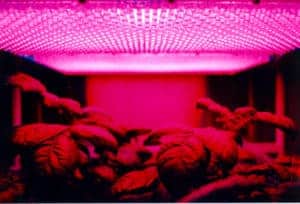A member of the beet family, Swiss chard is a resilient and easy-to-grow plant with good flavor in the leaves and stems, both edible cooked or raw. There are also a ton of varieties to choose from of different colors and flavor profiles. Swiss chard is typically grown in cool weather outside, but unlike lettuce or spinach it won’t bolt (make a flower stalk) easily, so you can keep growing and harvesting the same Swiss chard plants indoors all season long.
Growing Swiss chard indoors is an excellent choice for the first-time indoor gardener. Swiss chard grows relatively quickly and isn’t fussy about growing conditions. You can grow Swiss chard in a container as small as 1 gallon (3.8 L) and 6 inches (15 cm) deep, filled with well-draining potting mix. Larger containers will give you larger full-sized Swiss chard. Give Swiss chard at least 10 to 18 hours of light under grow lights and for optimal growth, feed with an all-purpose or higher nitrogen fertilizer every 7-14 days as it matures. Harvest at any time by picking only the larger outer leaves and leaving the inner leaves to continue growing.
On this page:
Can I Grow Swiss Chard Indoors?
Successfully growing your own chard indoors very easy and doesn’t require much when compared to growing other vegetables indoors. The best reason to start growing your own Swiss chard indoors is that you can get a ton of Swiss chard in a relatively small space all year round. There is something about sautéeing some homegrown chard or cutting it up into a fresh salad when it’s still blistering cold outside in winter.
But even if you’re growing in the middle of summer, there are more reasons to grow your own Swiss chard. Indoors, you don’t have to deal with any pest pressure and generally no fungal diseases. I’m speaking from personal experience that leaf miners – little flies whose larvae eat the inside of leaves – will easily destroy an entire large Swiss chard leaf in a few days and requires daily checks to keep under control. Indoors, you can enjoy massive, picture-perfect chard.
A good reason to grow Swiss chard over other leafy greens is that they don’t take up as much space. They can grow just fine in a container as small as 1 gallon (3.8 L) and 6 inches (15 cm) deep. Use a slightly larger container and you can grow bigger and juicier Swiss chard than you can find at any supermarket. Moreover, you can plant your chard closer together or put their containers closer since their leaves point upward and grow vertically rather than spread out like kale or bok choy. And if you prefer baby chard, cram those plants just a few inches apart and you’ll have plenty to snack on.

Sowing, Container and Spacing Requirements, Fertilizer Care, and Harvesting
Swiss chard is relatively easy to grow and can thrive in less than ideal conditions and flourishes even with standard all-purpose liquid fertilizer. Fertilize every 7-14 days as per your fertilizer’s instructions, but indoors you can get away with monthly feedings without any issues.
If you are starting from seed, you can start the seeds in small containers or seed starting trays or directly sow into their final pot. Sow 1-3 seeds per hole (the older the seeds, the more I sow), and thin them out later. Note that Swiss chard seeds are actually dried seed pods and you may get two, three, or even four plants sprouting out of one planted “seed”. As previously mentioned, unless you want to grow baby chard, use a minimum of a 1 gallon container at least 6 inches deep.
Harvesting is easy: just pick the larger, outer leaves first and leave the small baby leaves so your Swiss chard can continue growing. You can pick chard at any time, whether you want baby chard or full-sized leaves.
You can read more in my article on growing Swiss chard in containers, which applies to both outdoor and indoor container gardening.
Swiss Chard Indoor Lights
Swiss chard has moderate light requirements, similar to kale. Outside, they grow optimally in full sun but tolerate partial shade. That means indoors, you should give your chard 10 to 18 hours of light per day. Why not 24 hours? Dark periods are important for plant development, but different types of plants can tolerate varying levels of light.
As a leafy green, you can get away with using T5/T8 fluorescent bulbs or compact fluorescent lights (CFLs), but keep them very close without touching the top of the plant. The other option which I now prefer are LED grow lights. They are energy efficient and now come in full-spectrum natural white instead of the blue and red LED grow lights that were much more common in the past. For affordable but effective grow lights, I prefer SANSI LED grow lights. After seeing someone grow a full-sized pepper plant (video below) with one 36 watt LED bulb, I had to try it. Long story short, I use them for all my seed starting and also grow peppers and salad greens in winter with them.
There is another option I didn’t mention, metal halide bulbs, but they are so powerful, it’s really not worth the cost of using them just to grow Swiss chard.
